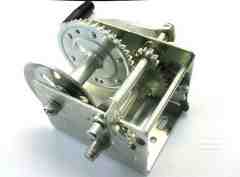The hydrolic system for braking is used for drum brakes and disk brakes, disk brakes are more efficient because they don't hold sea water like drum brakes.
CABLE BRAKES
Another method of braking is cable braking - this works by the same medthod as a hand brake on your car. it is not as efficient as the hydrolic system becuase the brakes can only be used when the trailer is stationary or un-hitched.
Both types of brakes are available in drum and disk brakes, disk brakes are more expencive but are more effective and don,t need as much up-keep.
WHEELS & TIRES
- Dont ever be tempted to put car tires on a trailer this is because trailer tires hav much stonger side walls than ordanary car tires this is because - trailers have to suport more weight, under constant threat of damage whilst driving e.g. being kerbed etc, and sunlight/heat starts to perrish the rubber.
- On the sidewalls of trailer tires informs you that: the max load limits for the tires are ####. If there are two tires rated for 250kgs each, then the total weight on the trailer and the boat and gear--should be no more than 500 kgs for example.
- When possible keep tires out of the sun e.g. in a garage or storage unit.
- Most new trailers usually have bearing protectors. These are metal caps with springs that hold grease under pressure which stops water entering and corroding the bearing. If your trailer doesn’t have protectors, they can be be added to the hub. They are easy to fit to the hub and aren't verry expensive.
- There are a range of different hubs for trailers all with multipul stud patterns and sizes, so keep in mind that when/if you are buying a new wheel to pick out the right size for the hub.
- On boat trailers the hubs are galvanised and hardened, if you are building a boat trailer make sure you get the hubs galvanised to avoid replacing them so soon as a result of rust.
- The most common type of coupling is the simple ball and socket, found on most cars, there are diferent types of couplings though according to the size of the boat and trailer e.g.hydrolicaly (serge) braking coupling, cable braking coupling or basic non braked style. You can also get couplings that have a head that swivels which allows you to attach the trailer from an angle.
- If you have a bigger boat that needs to be towed by a bigger vehicle e.g. a truck you would have a different coupling on the trailer (these however are not so common).

WINCHES
- Generaly your winch should be rated to pull at least half the combined weight of your boat, motor and gear. Every so often you should check your winch for loose mounting bolts and parts within the winch housing.
- If you use an electric winch (usualy only on flash or big boats to big to winch up manualy), check that the power cord is in good condition and that there is no corrosion on the wire because you might over heat the winch if the current isn't making it to the winch cleanly (not 100%). Make sure your winch line doesn't rub up against anything while loading/unloading the boat. Check the line frequently for wear or fraying (the line could be a steel cable or a thick strop). Even a small amount of fraying or wear can significantly reduce the strenght of the cable/strop.
- L.E.D - efficient when it comes to power but power is not important when the car is running.
- Normal light bulbs are just as bright as L.E.Ds (plural)
- The casings of the lights need to be water proof or removable.
- Do not submerse the plug next to the coupling
- The best wire to use is strannded copper wire because it is flexable and break resistant.
-
- You can't travel more than 90km/h when towing trailers or other vehicles on the open road. You can only travel at this speed if you have a rigid connection between the vehicles.
- If you have a non-rigid connection between the vehicles (like a rope) you cannot exceed 50km/h on any road.
- Don't tow a trailer or another vehicle at the maximum speed unless you're sure you can do so comfortably and safely.
- Leave at least a four-second gap between you and the vehicle ahead - even more in bad weather. The extra weight you're towing can dramatically affect your ability to slow down and stop.
Leave at least a four-second gap between you and the vehicle ahead- Slow down before curves and avoid braking suddenly - especially on gravel or greasy roads. Use a lower gear when travelling downhill.
- Don't overload your trailer as this will affect its stability and control at any speed.
LINKS I USED
- http://www.nzta.govt.nz/vehicle/your/motorhomes.html
- http://www.pickyguide.com/sports_and_recreation/boat_trailers_guide.html
- http://www.boatus.org/onlinecourse/reviewpages/boatusf/project/info3c.htm
- http://www.ehow.com/list_7486041_boat-trailer-specifications.html
- http://www.synthx.com/articles/trailer-versatility.html




